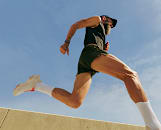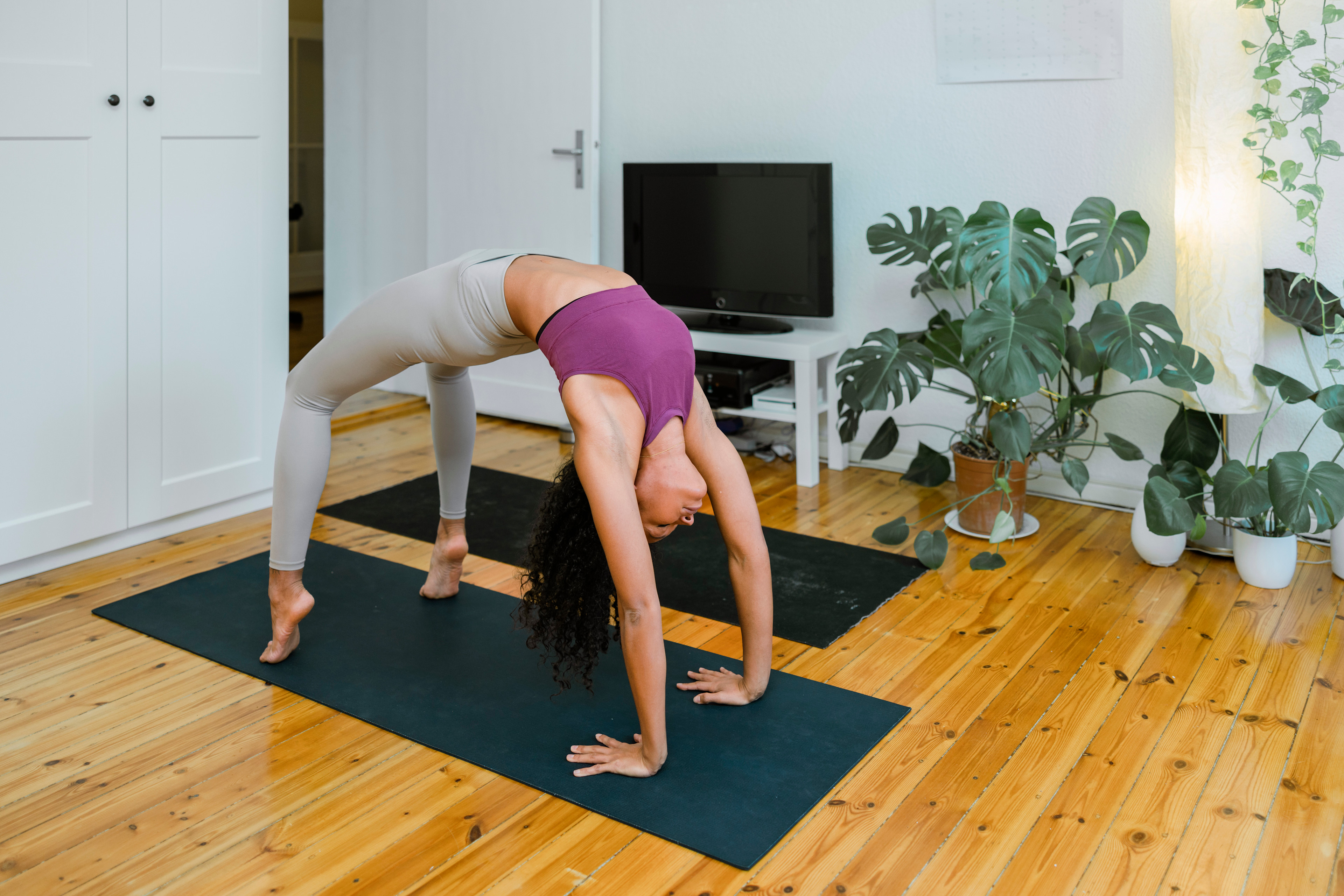
Portra via Getty Images
11 Yoga Backbends That Offer a Deep, Satisfying Stretch
These expansive postures offer a zing of energy for your body and mind.
By Leigh Weingus•
What Are Yoga Backbends?
Benefits of Doing Backbends in Yoga
11 Best Yoga Backbends to Try
Tips to Keep In Mind When Doing Yoga Backbends
How to Incorporate Backbends Into Your Yoga Practice
If the first image that comes to mind when you think of a yoga backbend is a super-flexible person contorting themselves into Wheel Pose (Urdhva Dhanurasana), let us be the ones to tell you that yoga backbends cover way more ground than that. They can also be much simpler and more beginner-friendly!
Discover more ways to reach your goals with Peloton
Yoga backbend poses range from tiny movements to big, sweeping ones, and all of them are amazing for your spine and body overall. Yes, they’ll give you a satisfying stretch that can help relieve your tech neck and undo some of those computer-related aches and pains, but they can also be a great way to strengthen the muscles along your spine.
To help you reap all the benefits of adding yoga backbends to your practice, we tapped Shayla Stonechild, a special guest in Peloton’s Power in Presence collection of yoga and meditation classes and a lululemon Ambassador with over 500+ yoga teacher training hours.
What Are Yoga Backbends?
Yoga backbends are a category of yoga poses that involve arching the spine backward and opening up the front part of the body, particularly the chest, shoulders, and hip flexors. Wheel Pose is perhaps one of the most well-known yoga backbends, but less dramatic postures such as Camel Pose (Ustrasana), Upward Facing Dog (Urdhva Mukha Svanasana), and even Cat Cow (Marjariasana Bitilisana) are also under the backbends umbrella.
While they can and should be done in a yoga class, gentle yoga backbends can also be incorporated into your day-to-day life. “I weave them into my daily movement, especially after long hours at my desk or after traveling,” Shayla says. “Backbends are a beautiful counterbalance to practices like breathwork or sound healing, where we’re doing a lot of inward work. They help integrate those shifts physically and somatically.”

Peloton App
Access thousands of classes with no equipment needed.
Benefits of Doing Backbends in Yoga
The list of yoga backbend benefits is practically endless, but here’s the short version: They can open your heart, strengthen the back of your body, boost your energy, and help you shake off stress like you just hit a reset button.
From a physical perspective, yoga backbends stretch the front of the body while strengthening the back, glutes, and legs. “Yoga backbends help counteract all of the slouching people do in a typical day,” explains Natasha Szucs, a physiotherapist at Allied Physiotherapy Health Group. “They open up the chest, shoulders, and hips while helping to strengthen back muscles and improve mobility. Plus, they can just feel really good!”
On that note, yoga backbends can also have mental and emotional benefits too: They’re energizing, mood-boosting, and can help reduce tension and stress (we do hold a lot of tension in our backs, after all). “Backbends aren’t just about flexibility, they’re about expansion,” Shayla explains. “They stretch the entire front body, strengthen the back body, and shift our emotional state. So many of us carry tension in the chest, shoulders, or heart space. Backbends invite us to move from protection to release.”
11 Best Yoga Backbends to Try
There are plenty of yoga backbends to choose from, with some being more beginner-friendly than others. Start with these poses below.
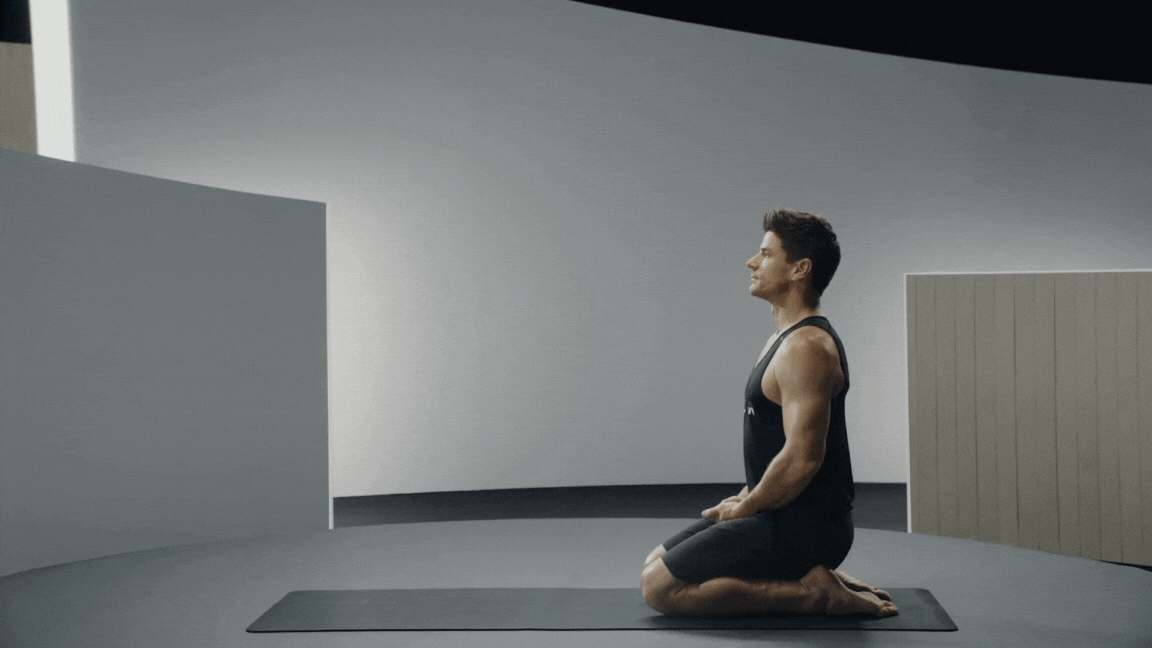
1. Camel Pose (Ustrasana)
Camel Pose is a kneeling backbend that stretches the front of the body (chest, hip flexors, and thighs) while strengthening the back and improving spinal flexibility. It’s also a deep heart and throat chakra opener, Shayla says. You can modify this one by tucking your toes under for extra height or keeping your hands on your lower back instead of reaching for your heels. Feel free to place yoga blocks next to your ankles for additional support, Shayla says.
Start in a tall kneeling position on your mat with your knees hip-width apart and your hips and shoulders stacked directly over your knees. Untuck your toes so the tops of your feet are on the floor.
Place your hands on your lower back, fingers pointing down. Lift through your chest and begin to lean back, keeping your hips stacked over your knees.
If accessible, reach your hands to your heels. Keep your neck neutral or gently drop your head back. Hold for 3 to 5 breaths.
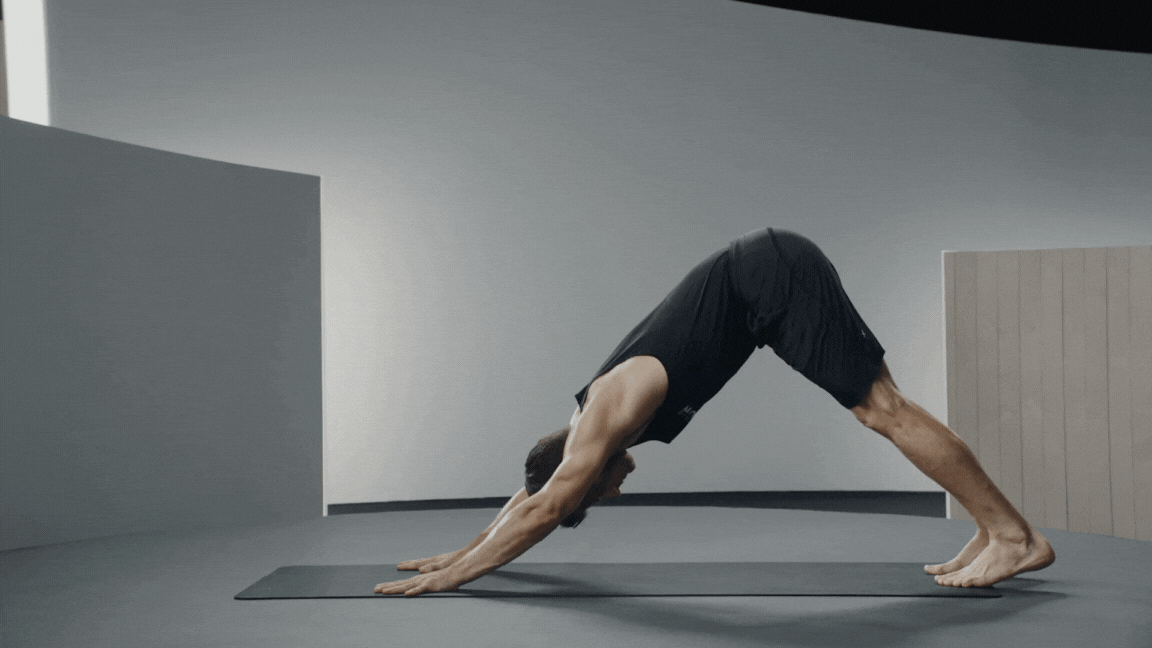
2. Upward-Facing Dog Pose (Urdhva Mukha Svanasana)
Upward-Facing Dog is a dynamic backbend typically seen in Sun Salutations and Vinyasa flows, which opens the chest, strengthens the arms, and stretches the front of the body. This can be modified by lowering to Cobra Pose or Low Cobra, keeping your legs and pelvis grounded.
Lie face down on the floor with your legs extended and the tops of your feet pressing into the mat.
Place your hands beside your lower ribs. Press into your palms to lift your chest, arching your back and reaching the top of your head toward the sky.
Engage your core and push into the tops of your feet, straightening your arms (without locking your elbows), so your thighs and knees hover off the mat. Keep your shoulders relaxed and away from your ears.
Hold for 3 to 5 breaths.
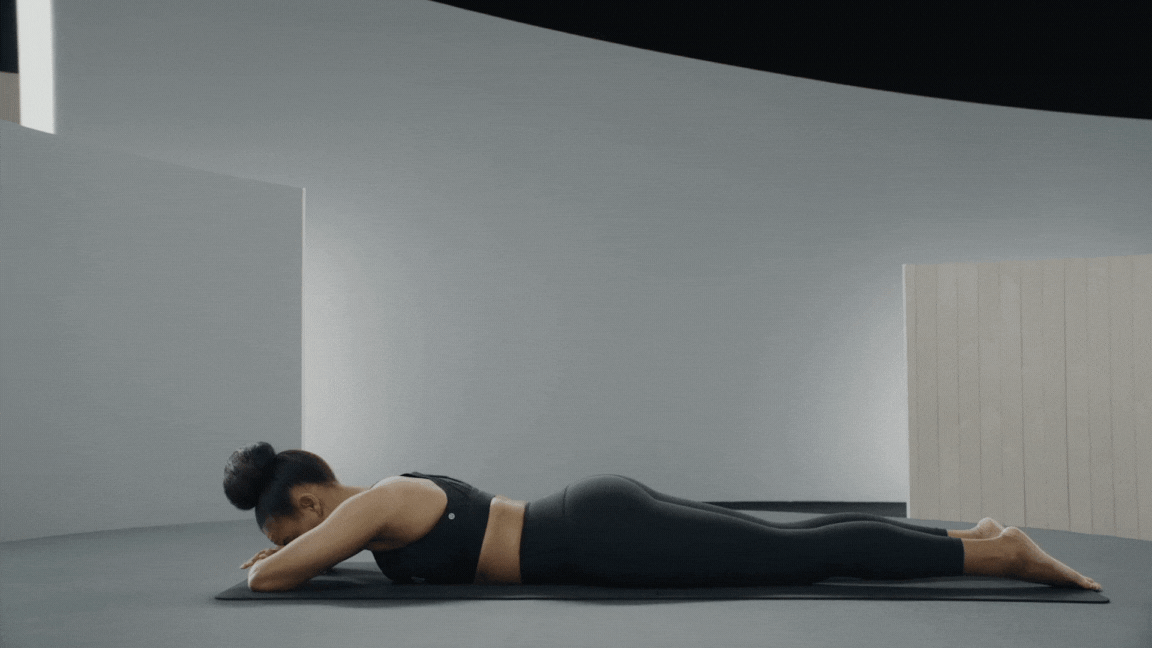
3. Cobra Pose (Bhujangasana)
Cobra is a prone backbend that lifts the chest off the mat using back strength and arm support, opening the heart and strengthening the spine. You can modify this posture by taking Low Cobra instead, keeping your elbows deeply bent and your chest closer to the mat.
Lie face down on the floor with your legs extended and feet hip-width distance apart, tops of your feet pressing down.
Place your palms on the floor beside your shoulders and press into your hands to lift your head and chest off the floor.
Straighten your arms slightly without locking your elbows. Keep your shoulders relaxed and pelvis grounded on the floor.
Hold for 3 to 5 breaths.
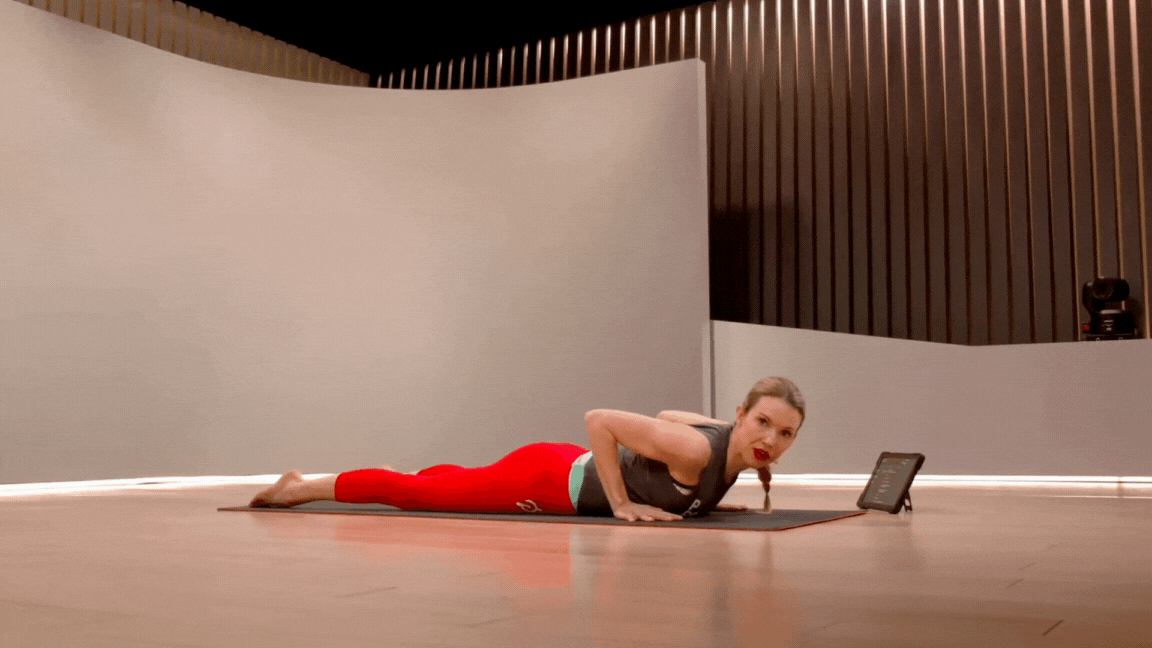
4. Low Cobra Pose (Ardha Bhujangasana)
Low Cobra (also called Baby Cobra) is a gentle, beginner-friendly backbend that activates the lower back muscles and helps build spinal awareness and strength. You can modify this pose even further by keeping your forehead on the mat and lifting your chest only slightly.
Lie face down on the floor with your legs extended and feet hip-width distance apart, the tops of your feet pressing down.
Place your palms on the floor beside your shoulders. Placing a light amount of weight in your hands, squeeze your shoulder blades back and down to lift your chest a few inches off the floor.
Keep your elbows bent and close to your sides, your neck long, and your pelvis and lower ribs grounded on the floor. Hold for 3 to 5 breaths.
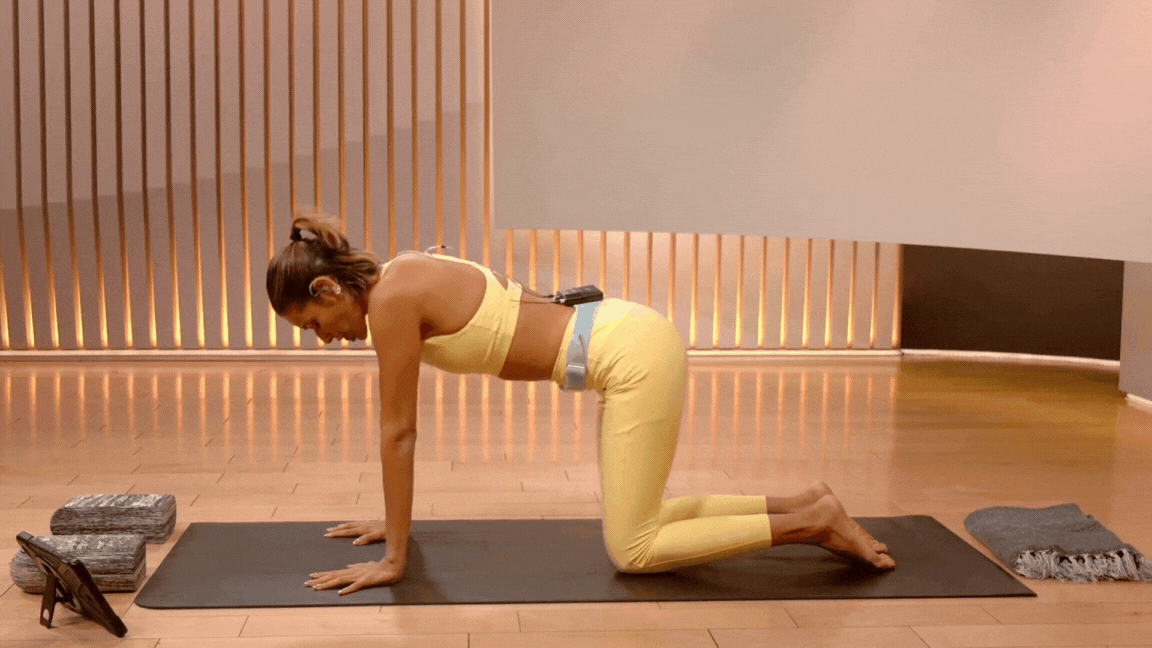
5. Cat Cow Pose (Marjaryasana Bitilasana)
Cat Cow is a flowing movement between spinal flexion and extension that warms up the spine, promotes mobility, and gently introduces the feeling of a backbend. To modify, you can add a folded blanket under your knees for extra cushioning.
Start in a tabletop position with your hands under your shoulders and knees under your hips.
Inhale, arch your spine, drop your belly, and lift your chest and tailbone to move into Cow Pose.
Exhale, round your spine, tuck your chin, and draw your belly toward your spine to move into Cat Pose.
Repeat for 5 to 8 breaths, moving with your breath.
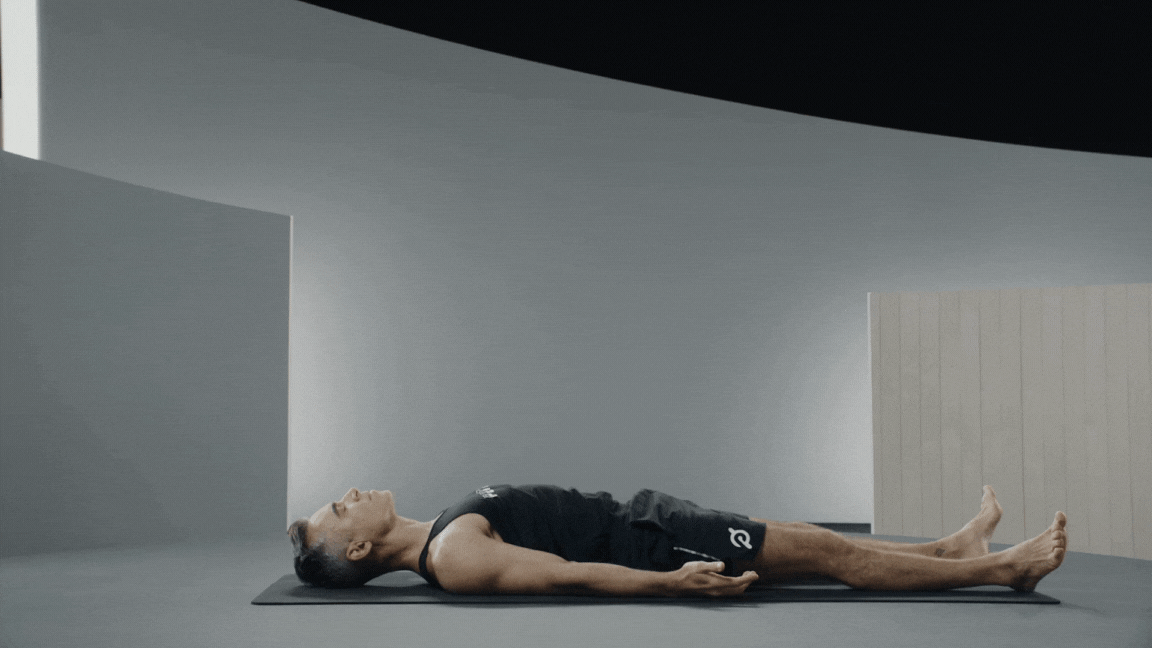
6. Bridge Pose (Setu Bandhasana)
A reclined backbend where the hips lift off the floor, Bridge Pose is a grounded, supportive option that opens the chest and stretches the front body while engaging the legs and glutes, Shayla notes. You can perform a modified, more supportive version of Bridge Pose by placing a yoga block under your sacrum.
Lie on your back with your knees bent and feet flat on the floor, hip-width apart. Rest your arms on the floor by your sides, palms down.
Press into your feet and lift your hips toward the ceiling, arching your back and opening your chest.
Clasp your hands under your back and roll your shoulders underneath you, if comfortable. Hold for 3 to 5 breaths.
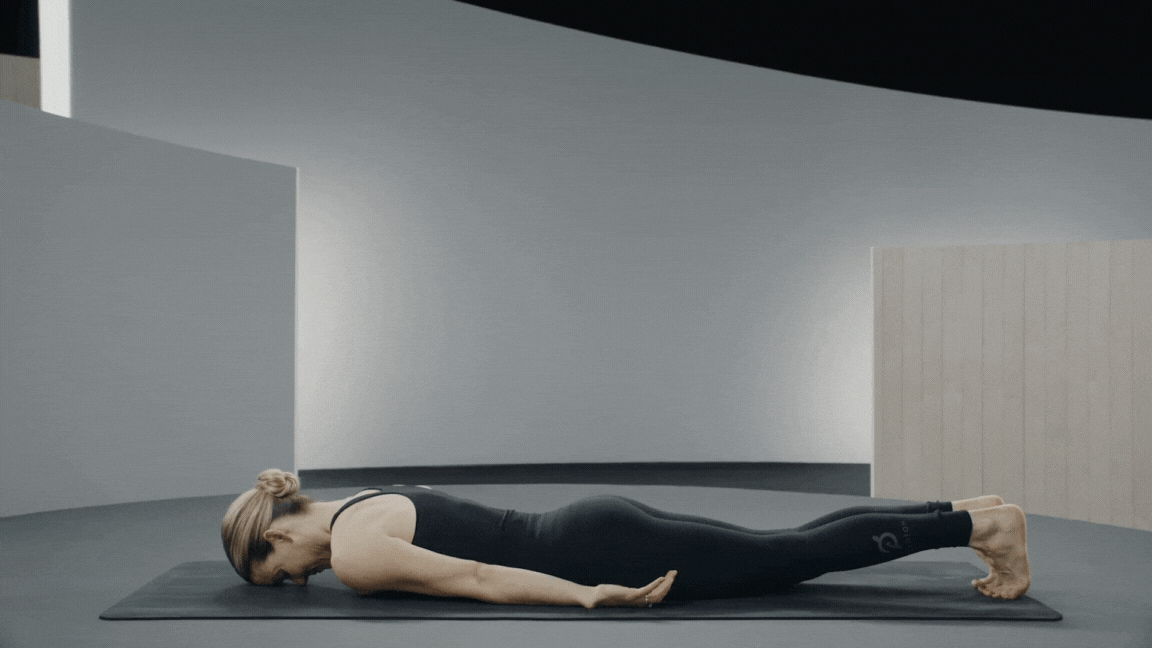
7. Bow Pose (Dhanurasana)
Bow Pose is a deep backbend performed on the belly, where you hold onto your ankles so your body forms a bow shape, stretching the front of your body and strengthening the back. This can be modified by performing Bow Pose one leg at a time or using a strap around your ankles.
Lie face down on the floor with your arms by your sides, palms facing up.
Bend your knees to lift your feet toward your glutes, and reach back to grab the outside of your ankles.
Inhale and lift your chest and thighs off the floor, kicking your feet into your hands. Gaze forward. Hold for 3 to 5 breaths.
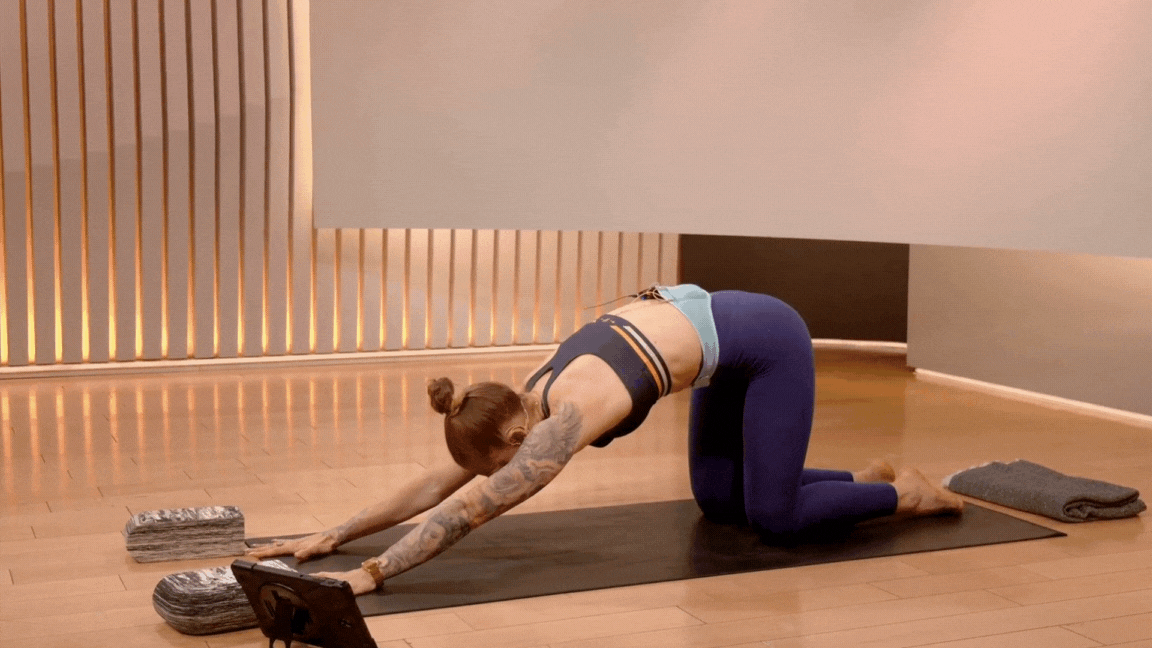
8. Puppy Pose (Uttana Shishosana)
A cross between Child’s Pose (Balasana) and Downward-Facing Dog (Adho Mukha Svanasana), this pose gently opens the shoulders, chest, and upper spine in a supported backbend. Place a blanket under your chest or knees for more support.
Start in a tabletop position with your hips over your knees, and your knees hip-width distance apart.
Walk your hands forward and lower your chest toward the mat, keeping your hips high and stacked over your knees.
Let your forehead or chin rest on the floor. Hold for 3 to 5 breaths.
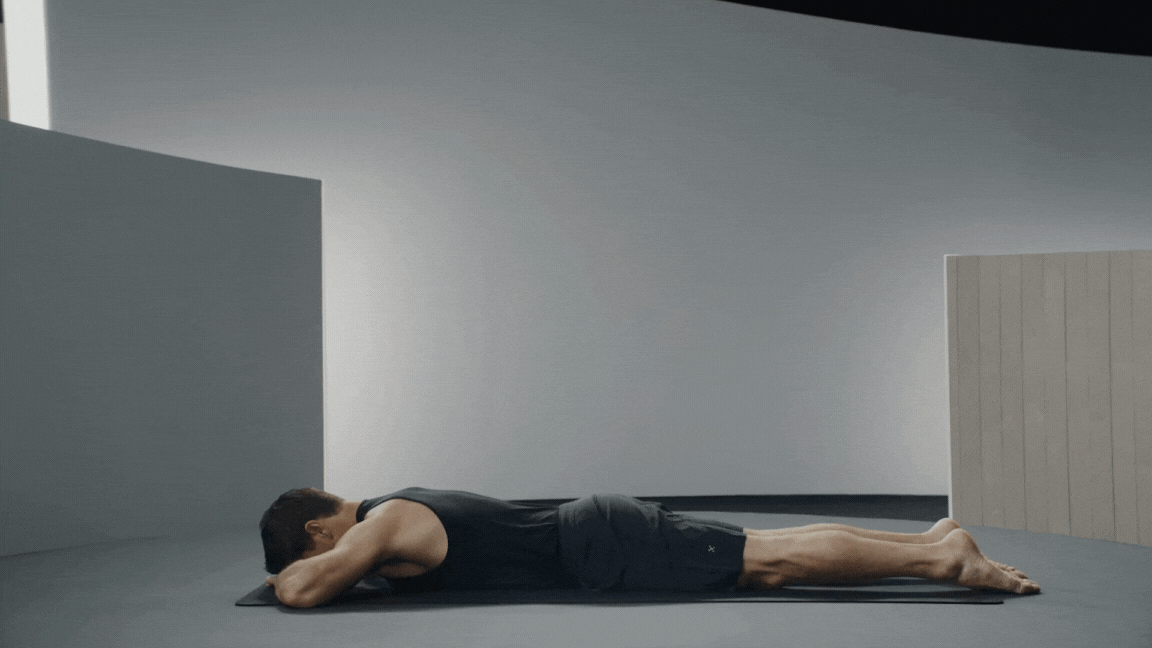
9. Sphinx Pose (Salamba Bhujangasana)
This is a gentle, forearm-supported backbend that provides a mild stretch to the lower spine and is accessible to most practitioners, Shayla says. Sphinx Pose (Salamba Bhujangasana) can be modified by placing a folded blanket under your elbows or lower ribs for more comfort.
Lie face down on the floor with your legs extended behind you, feet hip-width distance apart, and the tops of your feet on the mat.
Prop yourself up on your forearms with elbows directly under your shoulders and forearms parallel.
Gently lift your chest and draw your shoulders down your back. Hold for 3 to 5 breaths.
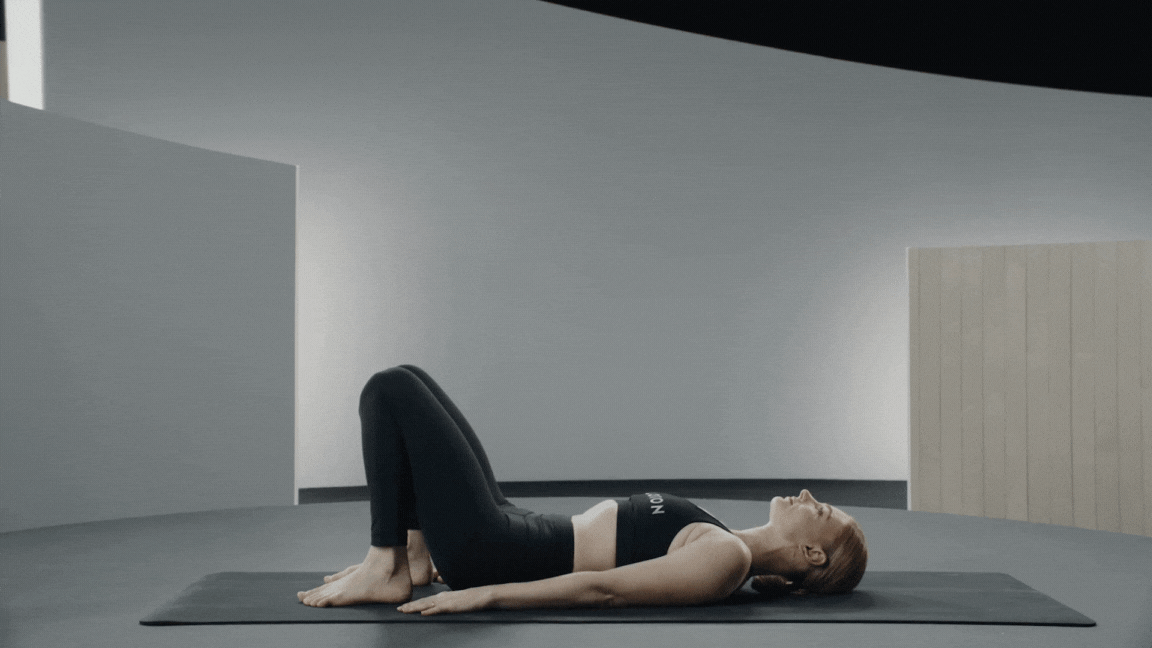
10. Wheel Pose (Urdhva Dhanurasana)
Wheel Pose is an advanced full backbend where the body arches into a wheel shape, requiring strength, flexibility, shoulder mobility, and energy to open the chest and spine. This can be modified by taking Bridge Pose instead, or you can work up to this pose by placing a block under your hands or shoulders. Shayla emphasizes the importance of warming up before attempting this pose—there’s a reason it’s often included toward the end of a yoga class.
Lie face up on the floor with your knees bent and feet hip-width apart.
Place your palms on the mat beside your ears, fingers pointing toward your shoulders, so your elbows point toward the ceiling.
Press into your hands and feet to lift your hips, chest, and head off the mat. Arch your back to reach your hips toward the ceiling, straightening your arms as much as possible.
Hold for 3 to 5 breaths.
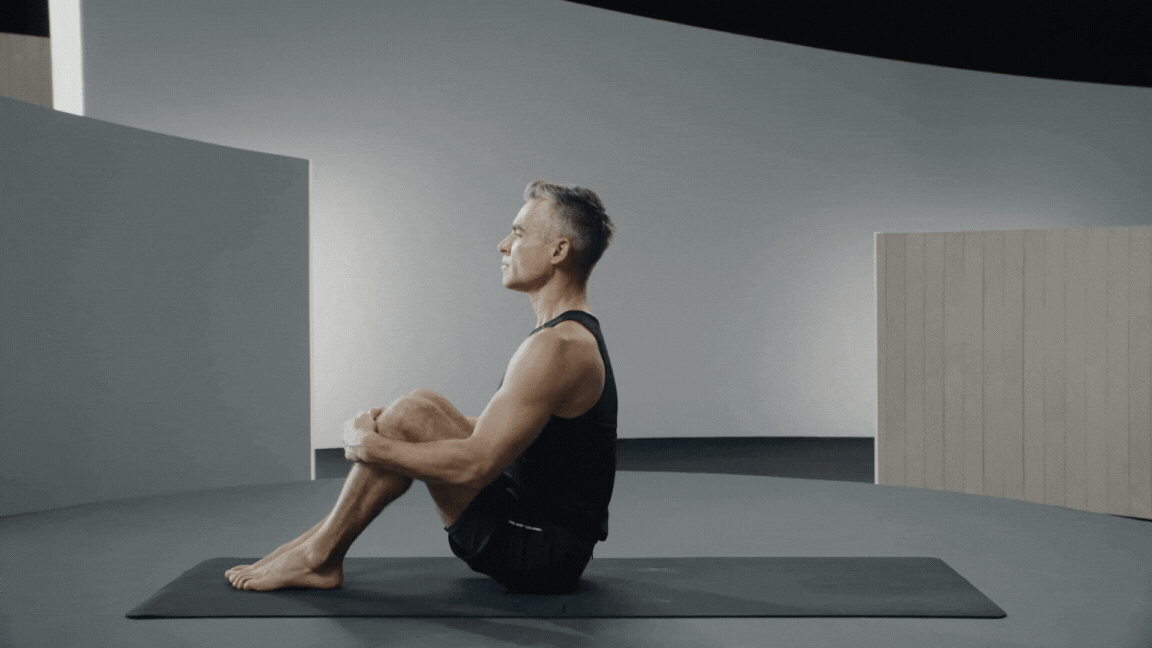
11. Fish Pose (Matsyasana)
A supine chest opener that arches the upper back and throat, Fish Pose is often used as a counterpose to forward folds or shoulder stands. This can be modified by placing a block or bolster under your upper back for a supported version.
Lie face up on the floor with your legs extended and arms on the floor by your sides.
Slide your hands under your hips, palms down, fingers pointing toward your feet. Press into your forearms to lift your chest.
Gently drop your head back so the crown of your head rests lightly on the mat. Hold for 3 to 5 breaths.
Tips to Keep In Mind When Doing Yoga Backbends
When it comes to mastering yoga backbends, Shayla’s top advice is simple but crucial: always warm up first. This is especially important before doing deeper backbends. Warming up with gentle movements helps ensure that your body is prepared for more advanced postures and is key for preventing injury.
When you’re in a backbend, think about engaging your legs and core to protect your lower back, Shayla suggests, and don’t shy away from using yoga blocks for extra support if needed. Also important: “Don’t forget to breathe,” she says. “If you’re holding your breath, you may have gone too deep.”
After performing a backbending posture, always be sure to counterpose—that is, always follow a backbend with something neutral like a Child’s Pose or a Forward Fold (Uttanasana), she says.
Finally, make sure to honor your body. “Not every backbend is meant for everybody, and that’s OK,” she says. You shouldn’t feel any pain during yoga backbends. If you have any existing injuries, consult with a healthcare provider first to make sure backbending is safe for you.
How to Incorporate Backbends Into Your Yoga Practice
According to Shayla, the best way to start incorporating yoga backbends into your practice is to choose one or two backbending poses to focus on per session. “Don’t overload your spine,” she says. “You can also theme a practice around a specific backbend and work your way towards it. Even just one gentle backbend held with intentional and mindful breathing can shift your day.”
On the Peloton App, you’ll find an array of guided yoga classes that incorporate backbends, including Focus Flow classes dedicated to backbends or individual poses, such as Wheel. To practice with Shayla, look for the Power in Presence collection in the Peloton App, where she’s teamed up with Peloton instructor Chelsea Jackson Roberts in a series of yoga and meditation classes.
If you’re new to backbending, start slow and gradually increase the holds or add in new variations when you feel ready, Shayla says. Remember, it’s not a race to see how quickly you can contort your spine into new positions—warm up, be patient, and modify when necessary.
This content is for informational and educational purposes only and does not constitute individualized advice. It is not intended to replace professional medical evaluation, diagnosis, or treatment. Seek the advice of your physician for questions you may have regarding your health or a medical condition. If you are having a medical emergency, call your physician or 911 immediately.
Want to strengthen your yoga practice?
We can help. Enter your email to get articles, instructor tips, and updates from Peloton sent to your inbox.
By providing your email address, you agree to receive marketing communications from Peloton.
For more about how we use your information, see our Privacy Policy.

